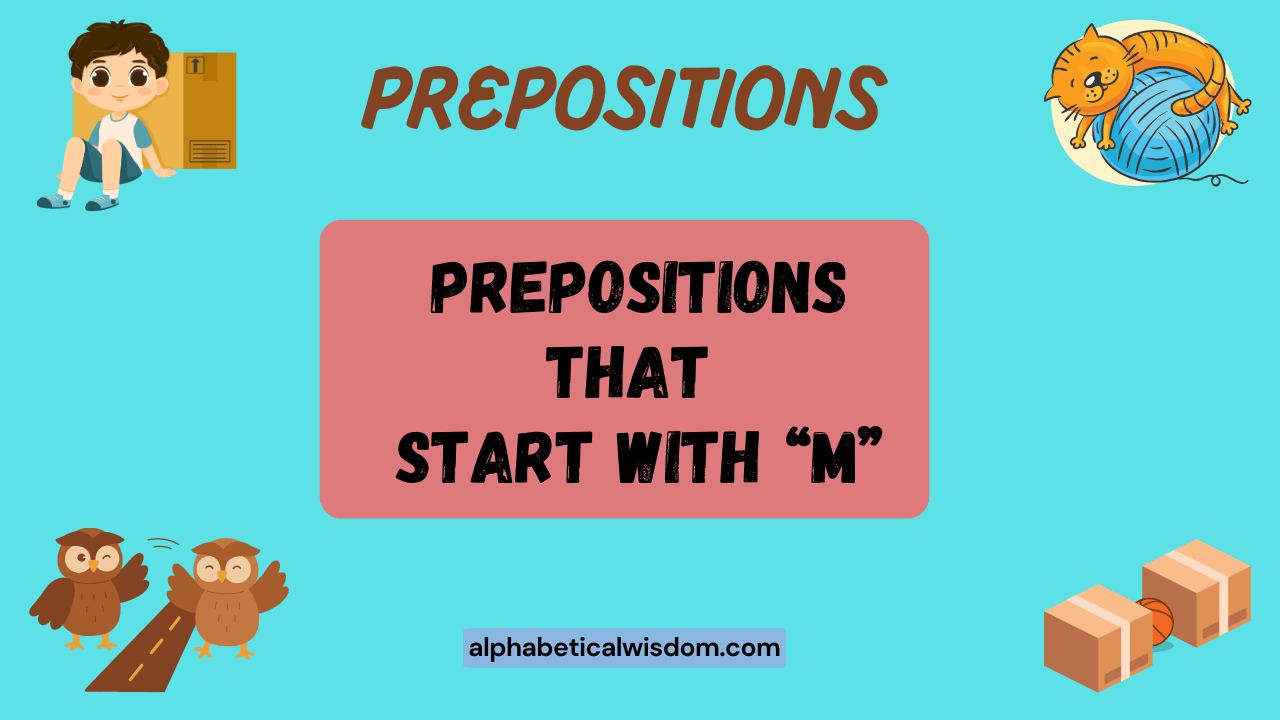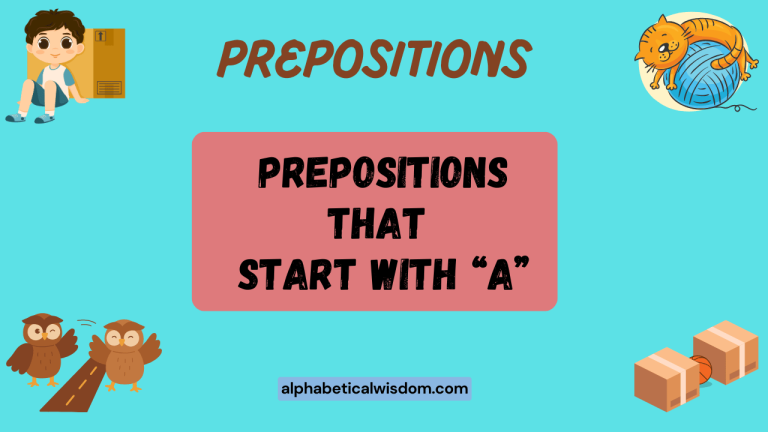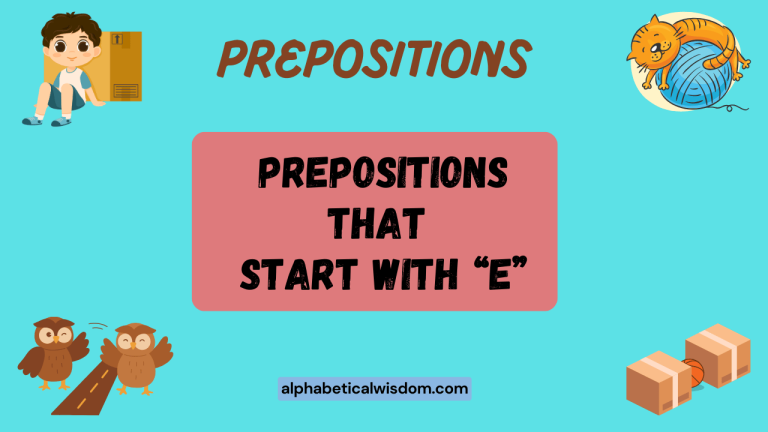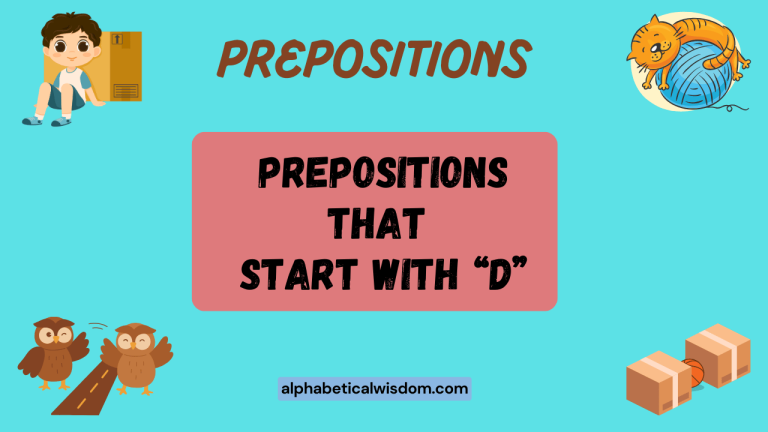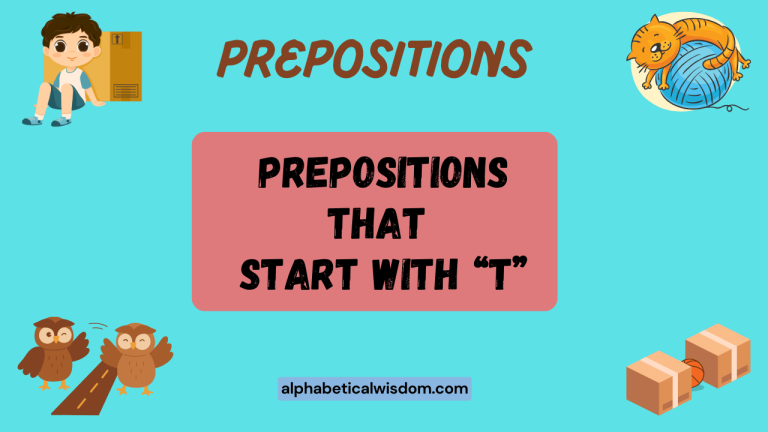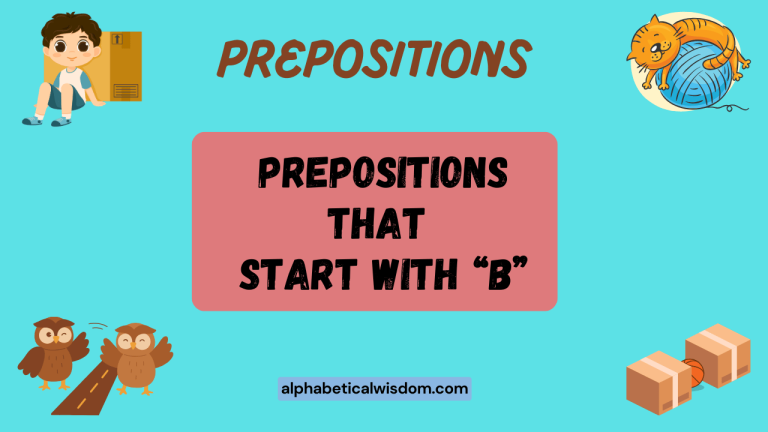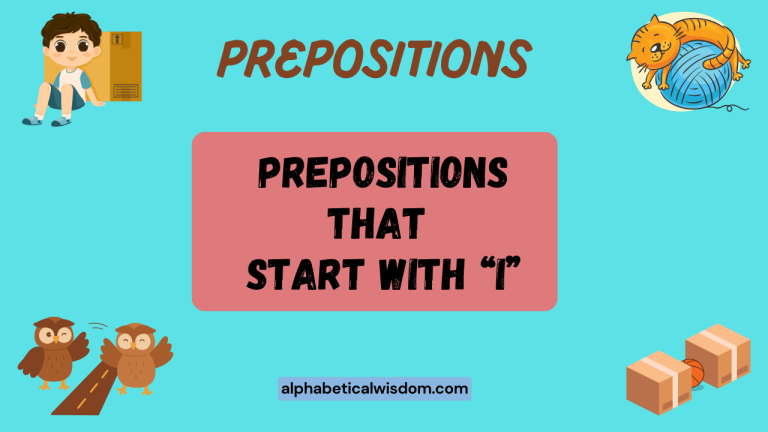Prepositions Starting With M: Mastering English Grammar
Prepositions are essential components of English grammar, acting as bridges that connect nouns, pronouns, and phrases to other parts of a sentence. They provide crucial information about location, time, direction, and relationships.
While many prepositions are commonly used and easily recognized, those starting with the letter “M” can sometimes be overlooked or misused. Mastering these “M” prepositions is crucial for achieving clarity and precision in both written and spoken English.
This article offers a comprehensive guide to understanding and effectively using prepositions that begin with “M.”
This guide is tailored for English language learners of all levels, from beginners seeking a foundational understanding to advanced speakers aiming to refine their skills. By exploring definitions, structural breakdowns, usage rules, and practical examples, readers will gain the confidence to incorporate these prepositions accurately and naturally into their everyday communication.
Furthermore, this article addresses common mistakes and provides ample practice exercises to reinforce learning and promote fluency.
Table of Contents
- Definition of Prepositions
- Structural Breakdown of Prepositions
- Types and Categories of Prepositions
- Examples of Prepositions Starting with M
- Usage Rules for Prepositions Starting with M
- Common Mistakes with Prepositions Starting with M
- Practice Exercises
- Advanced Topics
- Frequently Asked Questions (FAQ)
- Conclusion
Definition of Prepositions
A preposition is a word that connects a noun, pronoun, or noun phrase to other words in a sentence. Prepositions typically indicate the spatial, temporal, or logical relationship of the object to the rest of the sentence. They are called prepositions because they usually (but not always) come before the noun or pronoun they govern. This noun or pronoun is called the object of the preposition.
Prepositions are essential for constructing meaningful sentences and conveying precise information. They provide context and clarity by specifying the relationship between different elements within a sentence.
Without prepositions, it would be difficult to express ideas about location, time, direction, and association.
Consider the sentence: “The book is on the table.” Here, the preposition “on” indicates the spatial relationship between the book and the table. It tells us where the book is located in relation to the table. Similarly, in the sentence “I will see you in the morning,” the preposition “in” specifies the time when the action will take place. Prepositions add crucial layers of meaning to our language.
Structural Breakdown of Prepositions
Prepositions, while seemingly simple, often form part of larger prepositional phrases. Understanding the structure of these phrases can aid in correct usage.
A prepositional phrase typically consists of a preposition followed by its object (a noun, pronoun, or noun phrase). This entire phrase then functions as an adjective or adverb, modifying other parts of the sentence.
The basic structure is: Preposition + Object of the Preposition. The object of the preposition is the noun or pronoun that the preposition relates to the rest of the sentence. For example, in the phrase “near the river,” “near” is the preposition, and “the river” is the object of the preposition.
Prepositional phrases can also include modifiers that describe the object of the preposition. For instance, in the phrase “near the old, stone bridge,” “the old, stone bridge” is the object of the preposition, with “old” and “stone” acting as adjectives modifying “bridge.” The entire phrase still functions as a single unit, modifying a noun or verb elsewhere in the sentence.
Types and Categories of Prepositions
Prepositions can be categorized based on the type of relationship they express. The main categories include prepositions of time, place, direction, and manner.
Understanding these categories can help you choose the correct preposition for a particular context.
Prepositions of Time
These prepositions indicate when something happens. Common examples include at, on, in, before, after, since, until, during, and by. They help to specify the timing of an action or event.
Prepositions of Place
These prepositions indicate where something is located. Examples include at, on, in, above, below, under, over, beside, between, and among. They describe the spatial relationship between objects or locations.
Prepositions of Direction
These prepositions indicate movement or direction. Examples include to, from, into, onto, through, across, up, down, and along. They describe the path or direction of movement.
Prepositions of Manner
These prepositions describe how something is done. Examples include by, with, and in. They specify the method or means by which an action is performed.
Examples of Prepositions Starting with M
While the number of prepositions starting with “M” is limited, understanding their specific usages is vital for precise communication. This section will explore the prepositions “mid-“, “minus”, “modulo”, and “near” with detailed examples.
Mid-
The prefix “mid-” is often used to form adjectives and nouns that indicate the middle point or time of something. While not strictly a preposition, it functions similarly in certain contexts, indicating a position in the middle of a range or period.
It is often attached to other words to form compound words that act as prepositions.
Consider the word “midway.” It can function as an adverb or an adjective, but it implies a prepositional relationship of being in the middle of something. For example, “They stopped midway through the journey.” Here, “midway” implies a position in the middle of the journey.
| Sentence | Explanation |
|---|---|
| The battle occurred in mid-July. | “Mid-July” indicates the middle of July. |
| We arrived at the city in mid-afternoon. | “Mid-afternoon” refers to the middle part of the afternoon. |
| The price was reduced in the mid-range. | “Mid-range” specifies the middle part of the price range. |
| The project is in its mid-stages. | “Mid-stages” refers to the middle phases of the project. |
| The temperature is expected to be in the mid-twenties. | “Mid-twenties” means the middle part of the twenties in temperature (e.g., 24, 25, 26 degrees). |
| He felt a sharp pain in his mid-section. | “Mid-section” refers to the middle part of his body. |
| The event will take place in mid-October. | “Mid-October” indicates the middle of October. |
| The company announced record profits in the mid-year report. | “Mid-year” refers to the middle of the year, typically June or July. |
| The construction halted in mid-sentence. | “Mid-sentence” refers to the middle of the sentence. |
| The flower bloomed in mid-spring. | “Mid-spring” refers to the middle of spring. |
| The movie was set in mid-century America. | “Mid-century” indicates the middle of the century. |
| The negotiations reached a standstill in mid-discussion. | “Mid-discussion” refers to the middle of the discussion. |
| The singer hit a high note in mid-song. | “Mid-song” refers to the middle of the song. |
| The play reached its climax in mid-act. | “Mid-act” refers to the middle of the act. |
| The argument erupted in mid-conversation. | “Mid-conversation” refers to the middle of the conversation. |
| The hike was challenging, especially in the mid-mountain region. | “Mid-mountain” refers to the middle of the mountain. |
| The athletes competed in the mid-distance race. | “Mid-distance” refers to the middle distance of the race. |
| The project was completed in mid-December. | “Mid-December” indicates the middle of December. |
| The storm intensified in mid-ocean. | “Mid-ocean” refers to the middle of the ocean. |
| The event was scheduled for mid-week. | “Mid-week” refers to the middle of the week. |
| The research was conducted in mid-2024. | “Mid-2024” refers to the middle of 2024. |
| The product launch is planned for mid-season. | “Mid-season” refers to the middle of the season. |
| The announcement came in mid-ceremony. | “Mid-ceremony” refers to the middle of the ceremony. |
| The team made a crucial play in mid-game. | “Mid-game” refers to the middle of the game. |
Minus
While primarily known as a mathematical term indicating subtraction, “minus” can function as a preposition indicating exclusion or deficiency. It signifies that something is lacking or absent.
For example, “The cost is $50, minus tax.” Here, “minus” indicates that the tax is not included in the $50 price. It excludes the tax from the total amount.
| Sentence | Explanation |
|---|---|
| The weight limit is 20 kg, minus the container. | “Minus the container” excludes the weight of the container from the total weight limit. |
| The total score was 90, minus deductions. | “Minus deductions” excludes any deductions from the final score. |
| The recipe requires five ingredients, minus the optional spices. | “Minus the optional spices” indicates that the spices are not necessary for the recipe. |
| The price is $100, minus shipping costs. | “Minus shipping costs” means that shipping costs are not included in the $100 price. |
| The team consists of 11 players, minus the injured ones. | “Minus the injured ones” excludes the injured players from the team count. |
| The event is open to everyone, minus those under 18. | “Minus those under 18” excludes individuals below 18 years of age. |
| The instructions were clear, minus a few minor details. | “Minus a few minor details” means that some small details were not clearly explained. |
| The presentation was excellent, minus the technical difficulties. | “Minus the technical difficulties” implies the presentation would have been perfect without the technical issues. |
| The salary is $60,000, minus insurance contributions. | “Minus insurance contributions” excludes the insurance costs from the total salary. |
| The project will take six months, minus unforeseen delays. | “Minus unforeseen delays” excludes any potential delays from the estimated timeline. |
| The report is complete, minus the final appendix. | “Minus the final appendix” means that the appendix is not yet included in the report. |
| The package includes everything, minus the batteries. | “Minus the batteries” indicates that the batteries are not included in the package. |
| The meeting lasted two hours, minus the break. | “Minus the break” excludes the break time from the total meeting duration. |
| The warranty covers all parts, minus normal wear and tear. | “Minus normal wear and tear” excludes damage from regular use covered by the warranty. |
| The collection is complete, minus a few rare items. | “Minus a few rare items” means that some rare items are missing from the collection. |
| The cake is delicious, minus the excessive sugar. | “Minus the excessive sugar” implies the cake would be perfect with less sugar. |
| The experience was enjoyable, minus the long wait. | “Minus the long wait” means the experience would have been better without the long wait. |
| The movie was entertaining, minus the predictable plot. | “Minus the predictable plot” implies the movie could have been better with a more original storyline. |
| The service was prompt, minus the initial confusion. | “Minus the initial confusion” means the service would have been perfect without the initial mix-up. |
| The plan is solid, minus a few minor adjustments. | “Minus a few minor adjustments” indicates that some small changes are needed for the plan to be perfect. |
| The team is ready, minus final preparations. | “Minus final preparations” means that the team needs to complete some final steps before being fully ready. |
| The proposal is comprehensive, minus the executive summary. | “Minus the executive summary” means that the summary is not yet included in the proposal. |
| The event was a success, minus the unexpected rain. | “Minus the unexpected rain” implies the event would have been perfect without the rain. |
Modulo
In mathematics and computer science, “modulo” refers to the remainder after division. While not a preposition in the traditional sense, it can be used prepositionally to indicate a cyclical or repeating pattern.
It specifies a relationship based on the residue of a division operation.
For instance, in the context of time, one might say, “The clock resets modulo 24 hours.” This means that after every 24 hours, the clock returns to zero, indicating a repeating cycle.
| Sentence | Explanation |
|---|---|
| The counter resets modulo 100. | “Modulo 100” means that after reaching 100, the counter returns to 0. |
| The encryption key repeats modulo 256. | “Modulo 256” indicates that the key cycles after every 256 characters. |
| The week days cycle modulo 7. | “Modulo 7” means that after every 7 days, the week starts again. |
| The color palette repeats modulo 16. | “Modulo 16” indicates that the color cycle repeats after every 16 colors. |
| The sequence of numbers repeats modulo 5. | “Modulo 5” means that the sequence cycles after every 5 numbers. |
| The algorithm runs modulo the input size. | “Modulo the input size” means that the algorithm’s behavior is cyclic based on the input size. |
| The game board wraps around modulo its dimensions. | “Modulo its dimensions” indicates that when reaching an edge, the game board continues from the opposite side. |
| The calendar repeats modulo the number of days in a year. | “Modulo the number of days in a year” indicates the yearly cycle of the calendar. |
| The pattern of lights flashes modulo a fixed interval. | “Modulo a fixed interval” means the light pattern repeats after a fixed time period. |
| The data is indexed modulo the array length. | “Modulo the array length” means the index cycles through the array. |
Near
The preposition “near” indicates proximity or closeness in space or time. It signifies that something is not far away or is about to happen soon.
For example, “The bank is near the post office.” Here, “near” indicates that the bank is located close to the post office. It specifies the spatial relationship between the two locations.
| Sentence | Explanation |
|---|---|
| The park is near my house. | “Near my house” indicates the park is located close to my house. |
| The concert is near the end of the month. | “Near the end of the month” means the concert is scheduled towards the end of the month. |
| She lives near the beach. | “Near the beach” indicates her residence is close to the beach. |
| The store is near the intersection. | “Near the intersection” specifies the store’s location close to the intersection. |
| The project is near completion. | “Near completion” means the project is almost finished. |
| The train station is near the city center. | “Near the city center” indicates the train station is located close to the city center. |
| The deadline is near. | “Near” means the deadline is approaching soon. |
| The restaurant is near the museum. | “Near the museum” indicates the restaurant is located close to the museum. |
| The airport is near the highway. | “Near the highway” specifies the airport’s location close to the highway. |
| The vacation is near. | “Near” means the vacation is approaching soon. |
| The school is near the library. | “Near the library” indicates the school is located close to the library. |
| The summit is near the top of the mountain. | “Near the top of the mountain” means the summit is located close to the peak. |
| The end of the semester is near. | “Near” means the semester will end soon. |
| The stadium is near the river. | “Near the river” indicates the stadium is located close to the river. |
| The finish line is near. | “Near” means the finish line is approaching soon. |
| The café is near the office building. | “Near the office building” indicates the café is located close to the office building. |
| The holiday season is near. | “Near” means the holiday season is approaching soon. |
| The bridge is near the town. | “Near the town” indicates the bridge is located close to the town. |
| The new year is near. | “Near” means the new year is approaching soon. |
| The garden is near the house. | “Near the house” indicates the garden is located close to the house. |
| My birthday is near. | “Near” means your birthday is approaching soon. |
| The trailhead is near the parking lot. | “Near the parking lot” indicates the trailhead is located close to the parking lot. |
| The weekend is near. | “Near” means the weekend is approaching soon. |
Usage Rules for Prepositions Starting with M
Using prepositions correctly involves understanding the specific context and the relationship you want to convey. Here are some key rules for using prepositions starting with “M”:
- Mid-: Use “mid-” as a prefix to indicate the middle point of a time period, range, or object. Ensure the combination forms a recognizable word or phrase (e.g., mid-July, mid-range).
- Minus: Use “minus” to indicate exclusion or subtraction. It clarifies that something is not included in a total or condition (e.g., $100 minus tax, all attendees minus those under 18).
- Modulo: Use “modulo” in mathematical or computational contexts to indicate a repeating cycle or remainder after division. It expresses a cyclical relationship (e.g., the counter resets modulo 100).
- Near: Use “near” to indicate proximity in space or time. It signifies that something is close by or approaching (e.g., near the park, near the deadline).
Exceptions and Special Cases:
- The word “midst” is sometimes confused with prepositions starting with M. However, “midst” is a noun meaning “the middle of,” and is often used in the phrase “in the midst of,” which functions as a prepositional phrase.
- “Minus” might be replaced by “except for” or “excluding” in some contexts, but “minus” maintains a more mathematical or precise tone.
- “Near to” is sometimes used instead of “near,” but “near” is generally preferred for its simplicity and directness.
Common Mistakes with Prepositions Starting with M
Even experienced English speakers sometimes make mistakes with prepositions. Here are some common errors and how to correct them:
| Incorrect | Correct | Explanation |
|---|---|---|
| The event is in midst of planning. | The event is in the midst of planning. | “Midst” requires the article “the” to form the correct prepositional phrase. |
| The price is $50 minus of tax. | The price is $50 minus tax. | “Minus” does not require the preposition “of”. |
| The store is nearly the park. | The store is near the park. | “Nearly” is an adverb; “near” is the correct preposition. |
| Mid the summer, we traveled to Italy. | In mid-summer, we traveled to Italy. | “Mid” requires a hyphen when used as a prefix, and the phrase “in mid-summer” is more common. |
| The program resets modulo to 10. | The program resets modulo 10. | “Modulo” does not require the preposition “to”. |
| He lives near to the school. | He lives near the school. | “Near” is generally preferred over “near to” for simplicity. |
Test your understanding of prepositions starting with “M” with these exercises. Choose the correct preposition or prefix to complete each sentence. Identify and correct the errors in the following sentences.Practice Exercises
Exercise 1: Fill in the Blanks
Question
Answer
1. The concert is scheduled for _______-June.
mid
2. The cost is $20, _______ tax.
minus
3. The shop is _______ the train station.
near
4. The clock resets _______ 12 hours.
modulo
5. They arrived _______ the afternoon.
mid
6. The team consists of 10 players, _______ the injured ones.
minus
7. The deadline is getting _______.
near
8. The counter resets _______ 20.
modulo
9. The event will take place in _______-September.
mid
10. The price is $50 _______ shipping.
minus
Exercise 2: Correct the Sentences
Question
Answer
1. He lives nearly to the store.
He lives near the store.
2. The price is $100 minus of the discount.
The price is $100 minus the discount.
3. The meeting is in midst of planning.
The meeting is in the midst of planning.
4. The clock resets modulo to 60.
The clock resets modulo 60.
5. She arrived mid of the night.
She arrived in the mid of the night.
6. The temperature is near to freezing.
The temperature is near freezing.
Advanced Topics
For advanced learners, consider the nuances of using these prepositions in more complex sentence structures and idiomatic expressions.
- Figurative Language: Explore how “near” can be used metaphorically to describe abstract concepts like “near success” or “near failure.”
- Formal vs. Informal Usage: Understand when “minus” might be replaced by more colloquial expressions like “without” or “excluding.”
- Mathematical Contexts: Delve deeper into the use of “modulo” in advanced mathematical and computational theories.
Frequently Asked Questions (FAQ)
- What is the difference between “near” and “nearby”?
“Near” is a preposition that requires an object (e.g., near the park). “Nearby” is an adverb or adjective that does not require an object (e.g., the park is nearby; a nearby park).
- Can “minus” be used in formal writing?
Yes, “minus” is acceptable in formal writing, especially when conveying precise numerical or exclusionary information. However, consider the tone and audience to ensure it fits the context.
- Is “in the midst of” always necessary?
Yes, the phrase “in the midst of” is a fixed expression. You cannot omit “the” without changing the meaning or creating an ungrammatical sentence.
- How is “modulo” used in computer programming?
In programming, “modulo” (often represented by the % symbol) returns the remainder of a division operation. It’s used for tasks like wrapping around arrays, implementing cyclical patterns, and checking divisibility.
- Can “mid-” be used with any word?
No, “mid-” should only be used with words where it makes logical sense to indicate the middle. It should also form a commonly recognized or understandable compound word. For example, “mid-day” is acceptable, but “mid-apple” is not.
- What are some alternatives to using “minus”?
Alternatives to “minus” include “excluding,” “without,” “less,” and “except for,” depending on the specific context and the nuance you want to convey.
- Is “near to” grammatically incorrect?
While not strictly incorrect, “near” is generally preferred over “near to” because it is more concise and direct. “Near to” can sound slightly archaic or overly formal in modern English.
- Can “near” be used with abstract nouns?
Yes, “near” can be used with abstract nouns to indicate proximity in a non-physical sense. For example, “near success” means close to achieving success, and “near completion” means almost finished.
Conclusion
Understanding and correctly using prepositions starting with “M” – “mid-“, “minus”, “modulo”, and “near” – is essential for clear and precise communication in English. While the list is short, each preposition has specific contexts and rules that must be followed.
By mastering these prepositions, you can enhance your writing and speaking skills, ensuring your message is accurately conveyed.
Remember to pay attention to the context, practice using these prepositions in various sentences, and review the common mistakes to avoid errors. With consistent effort, you can confidently incorporate these prepositions into your everyday language use.
Continue practicing with different exercises and real-world examples to solidify your understanding and achieve fluency in English grammar.
